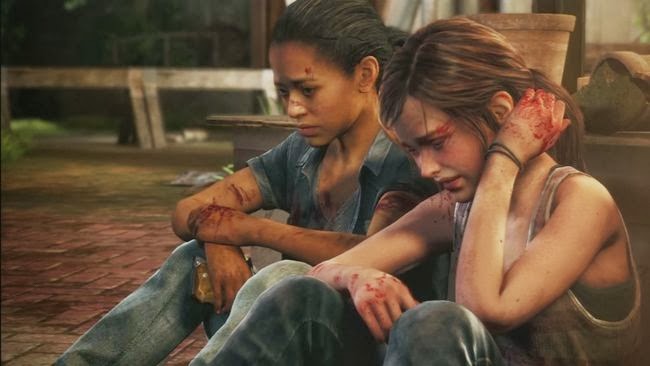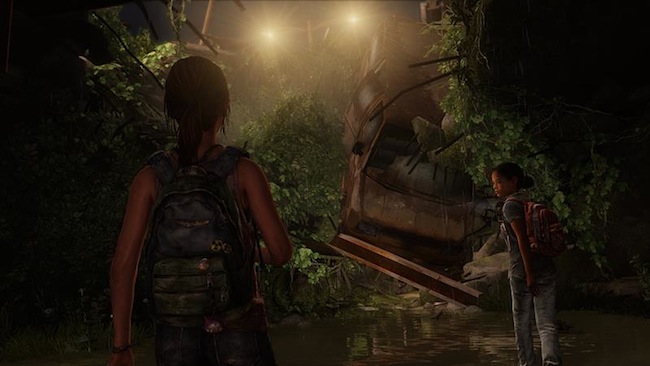
Naughty Dog’s 2013 post-apocalyptic masterpiece, The Last of Us left us with a world of stories begging to be explored. The journey of Joel and Ellie took interactive story-telling in an action driven game to new heights with its strong focus on character development and tight direction. It was the relationship between the two that formed the narrative’s emotional core that made the experience so powerful. But in the end, The Last of Us is Joel’s story. Ellie is the catalyst of their cross-country ordeal, and more importantly Joel’s catalyst for trying to rediscover his humanity and find redemption. While Joel’s motivations are somewhat clear throughout, it’s not until the game’s abrupt finale that we learn about Ellie’s. In turn, more of her story is told through a comic series released by Dark Horse, and her (presumably) most decisive, formative moments are explored in a new DLC chapter, Left Behind.
Left Behind functions to fill in two missing narrative gaps in the main story: Ellie’s life before Joel, and the time between the Autumn and Winter chapters. It’s an interesting piece of intertwining narrative as you’re left wondering about the connection between the two story lines and then how they fit in with the ending scene of the original game, which is recapped at the start of the DLC. At the narrative’s core is Ellie, and two relationships that have defined her character. Left Behind introduces us to Riley; Ellie’s best-friend at a Boston military school who returns after having disappeared without a word weeks before. Their story is set a few weeks before the events of The Last of Us, acting as an exploratory experience designed to flesh out their characters and relationship.

The strength of Naughty Dog’s writing shines through as the pair work through their feelings, both of betrayal and the happiness they bring to one another in this grim post-apocalyptic world. Their interactions are believable, funny and tender, and you get the feeling some of Ellie’s attitude was rubbed off from the slightly more adventurous Riley. In stark contrast is the Colorado section where Ellie is in a desperate search to find supplies to keep Joel alive. While not obvious at first, the connection between the two sections starts to make sense, and Ellie’s determination to keep Joel alive takes on new meaning, which then shines more light on The Last of Us’ ending.
Gameplay remains fundamentally unchanged in Left Behind as Ellie goes about the usual scavenging, crafting, sneaking and stabbing from the main game. Ellie and Riley’s portion is almost free of action, and instead involves exploration and plot exposition as their characters and relationships are fleshed out. It’s also where the game uses some clever ideas to engage with the story and characters in an interactive way. In truth, One could derisively call these moments “mini-games” – which, to be honest, is what they are – but, they fold seamlessly into gameplay. These moments are all times where Ellie and Riley attempt to repair their fractured friendship and really draw you in emotionally to the story. In my opinion, they’re moments which are best experienced without prior knowledge – so I won’t spoil them – however, let’s just say that earning the “Brick Master” achievement is very satisfying.

With that being said, If you weren’t a huge fan of the shooting mechanics portions of The Last of Us, then you’re unlikely going to be swayed by Left Behind. The action occurs mostly during the Colorado section as Ellie hunts down supplies to keep Joel alive. Encounters are tough, and Ellie, for the most part, is extremely limited in terms of weapons and supplies; meaning caution and strategy are extremely important during these sections. Although, things do get interesting when you enter scenarios with human hunters and infected; setting up opportunities to pit them against each other before coming in to mop up the remains (or use molotovs, always use molotovs).
Naughty Dog didn’t hold back presentation-wise, offering some stunning set-pieces and dynamic visuals to set it apart from the main game. The art direction of The Last of Us was focused on the somewhat cliché downfall-of-society and nature-reclaiming-civilisation tropes, which look fantastic while Left Behind centres around an area that still has some of the vestiges of modern life we recognise. The girls’ trip through the Boston mall is a treat to explore as Naughty Dog crammed each area with little details and areas to interact with. It was easy to waste time in the Halloween store with all the little context-based moments between Ellie and Riley and the carousel section is quite serene. The motion captioning and animation of the pair is spot on, which they have to be with so many scenes tightly focused on their faces and expressions. This section is in stark contrast to the Colorado sequence, which is nearly devoid of colour. Winter is on its way, and snow has invaded every open space of the shopping centre Ellie lurks around, making the environment feel muted and oppressive. What’s thematically at stake is reflected by the stark contrast of the two segments’ environment to build a unique atmosphere for each.
Clocking in at around 2-3 hours for $21.95, Left Behind may not seem like great value for money, but it more than delivers on every level. Game time is a contentious issue these days with blockbuster titles coming out with incredibly short campaigns, seemingly out of sync with the cover price. Length, however, is increasingly becoming linked to quality as we’ve seen with games such as Journey and The Stanley Parable. Left Behind delivers a powerful story in an incredibly well designed, brand new, and fleshed out environment, which is no mean feat by itself. The story draws you further into their world, and is paced expertly to leave you satisfied, despite its length.











